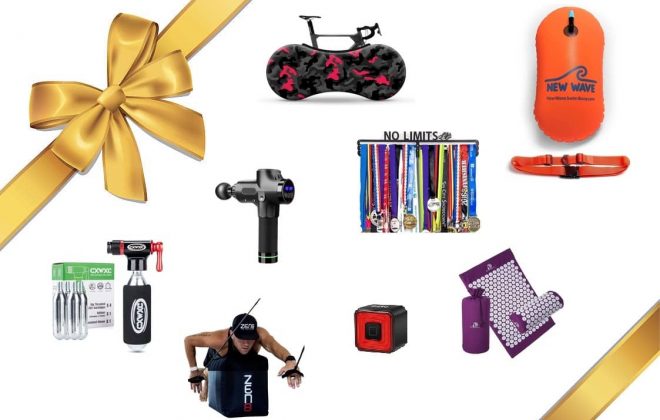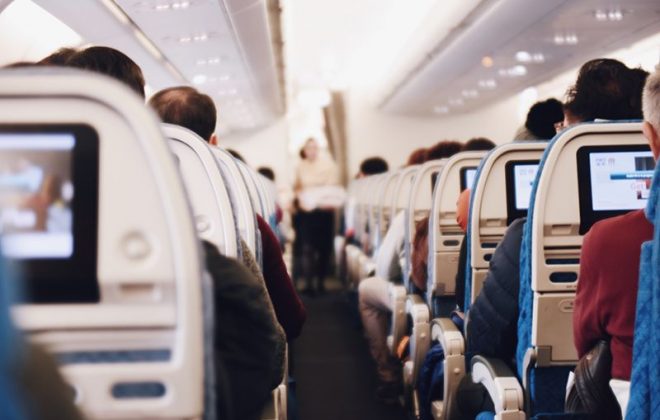QuietOn 3.1 – Will Noise-Cancelling Sleepbuds Make You Sleep Better?
In a world filled with distractions and constant noise, the quest for a peaceful night’s sleep has become more elusive than ever. Enter noise-cancelling sleepbuds – the latest innovation promising to revolutionize our nightly routines and potentially enhance the quality of our sleep.
To be honest, I have never heard of the word ‘sleepbud’ before, let alone a noise-cancelling sleepbud. But hey, the world (and science) is moving at a turbocharged pace and the whole idea kind of makes sense.
Sleepbuds are these teeny tiny wireless devices that are designed to block out ambient sounds and create an environment conducive to restorative sleep. Kind of like a meditation retreat guides users into a tranquil state. But amidst the hype, the question remains: will these noise-cancelling sleepbuds deliver on their promise of better sleep, or are they just another fancy gadget in an ever-expanding market of wearables?
As an athlete and a coach I’m curious about technology that can help improve performance. And since sleep is the key performance enhancer, I was naturally eager to try out this particular one. So, what follows is my personal review of QuietOn 3.1 – the current market leader in noise-cancelling sleepbuds.
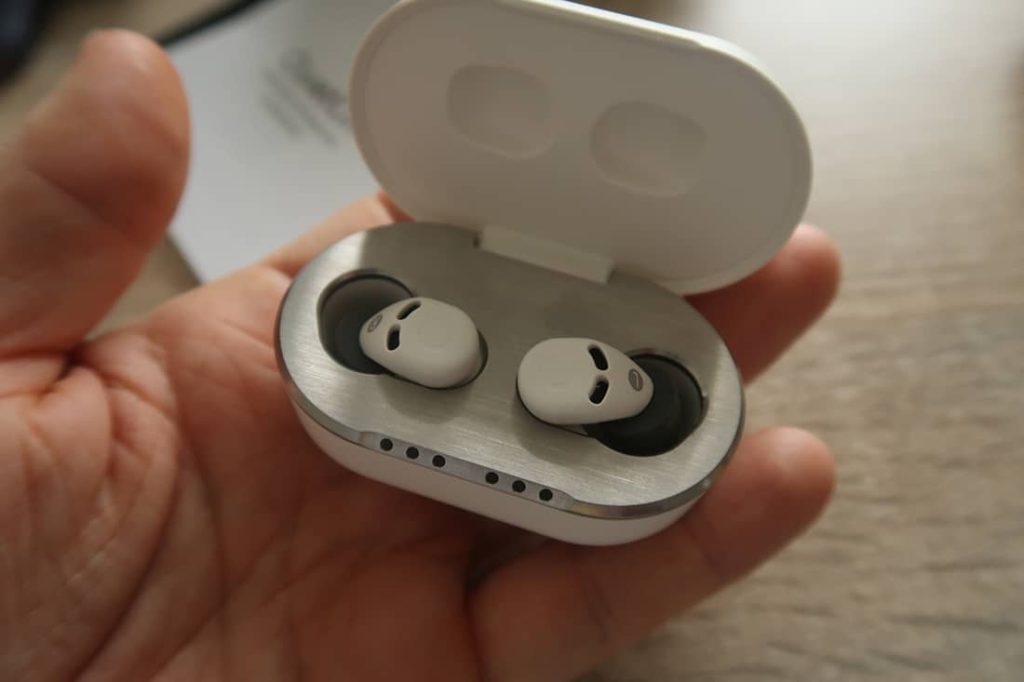
Why would athletes even need noise-cancelling sleepbuds?
First – the big question. Why should athletes care?
Short answer – because the quality of sleep is directly related to physiological performance. Athletes place a high load on their bodies with each training session and need to be able to recover quickly for the next key one. The better (and quicker) they recover, the more training load they can go through. Which increases their overall training effect.
Our rate of regeneration is quickest during sleep, as changes in body’s internal processes foster that. Among others, the heart rate slows down, blood pressure decreases, blood vessels across the body dilate (including in the brain and stomach), muscle tension eases. All of that promotes better blood flow throughout the body and normalizes the work of all systems. Moreover, during sleep brain activity slows down, allowing the nervous system to relax, leading to improved reflexes, better coordination, faster reaction time, better concentration and, of course, more willpower. All of that helps athletes to show up 100% for their practice sessions.
Read also: How To Get Better Sleep: 12 Proven Sleep Hygiene Tips For Athletes
Poor quality (or insufficient) sleep does exactly the opposite. It doesn’t allow the body to repair itself from the combined stress of daily life, training and competitions. Ultimately, this may lead to to accumulation of fatigue, performance decline and even training plateau. On top of that, since stress affects the immune system, sleep-deprived athletes are also more susceptible to illness.
It makes all the sense in the world to do everything possible to improve the quality of sleep. In particular, some of the activities include improving sleep hygiene, using natural remedies (i.e. lavender or by creating a wind-down routine), soundproofing the apartment and, of course, using the old-school solution – earplugs.
Now that is the niche that noise-cancelling sleepbuds aim to fill.

The Resilient Athlete
A Self-Coaching Guide to Next Level Performance in Sports & Life
Are you aiming to become a resilient athlete who is able to withstand any pressure? Be able to jump on any opportunity? Take any challenge life throws at you head on?
Then this book is for you.
Learn moreQuietOn 3.1 noise-cancelling sleepbuds – key features
QuietOn 3.1 are basically tiny earbuds that fit nicely in the ear while you sleep (or doing anything else, really). Thanks to noise-cancelling technology these essentially eliminate the most common barrier to a quality sleep – background noise. Traffic, snoring, loud neighbourhood, TV in another room or people chatter. Partially even the hum of airplane engines.
This reduces the ‘pressure’ on the nervous system and allows users to relax, fall into deeper sleep phase easier and have fewer distractions throughout it.
What’s in the box
Inside the box you’ll find the magnetic charging snap case (with sleepbuds inside, obviously). A USB-A to USB-C cable is also included.
The case is robust – white plastic exterior, brushed stainless steel on the inside with gold pins to connect the sleepbuds. It’s similar size to Apple’s AirPods case and fits well in the pocket.
Besides the sleepbuds themselves, there are four different tip sizes made of memory foam to choose from to get the seal right for the noise cancellation to work properly. For me the size S (that was already on) felt good, so I never tried different tip sizes. In all honesty, it was a little tricky to take them off, so I didn’t try much.
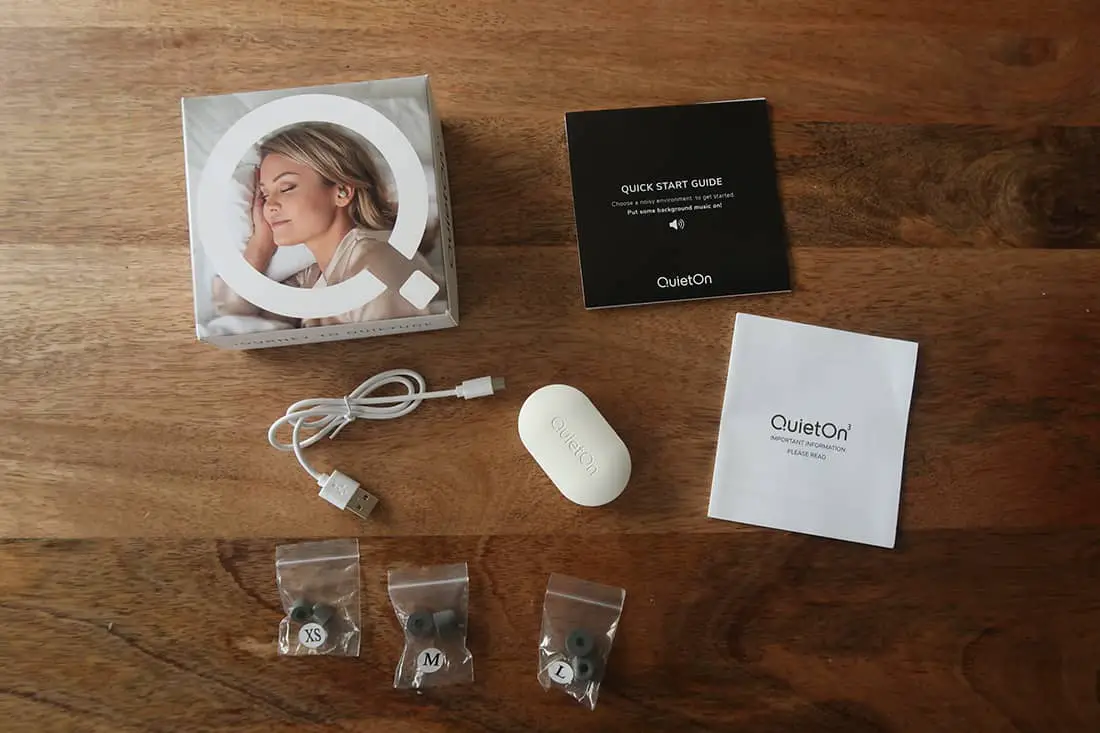
First impressions – design, comfort & fit
QuietOn’s noise-cancelling sleepbuds are quite aesthetically pleasing. The case is sophisticated and satisfying to hold. The design of the sleepbuds itself is simple yet smart. I expected nothing less from a product designed in Scandinavia.
Once they’re in, they’re very comfortable to wear, and you hardly notice them in your ear. Even when falling asleep on your side.
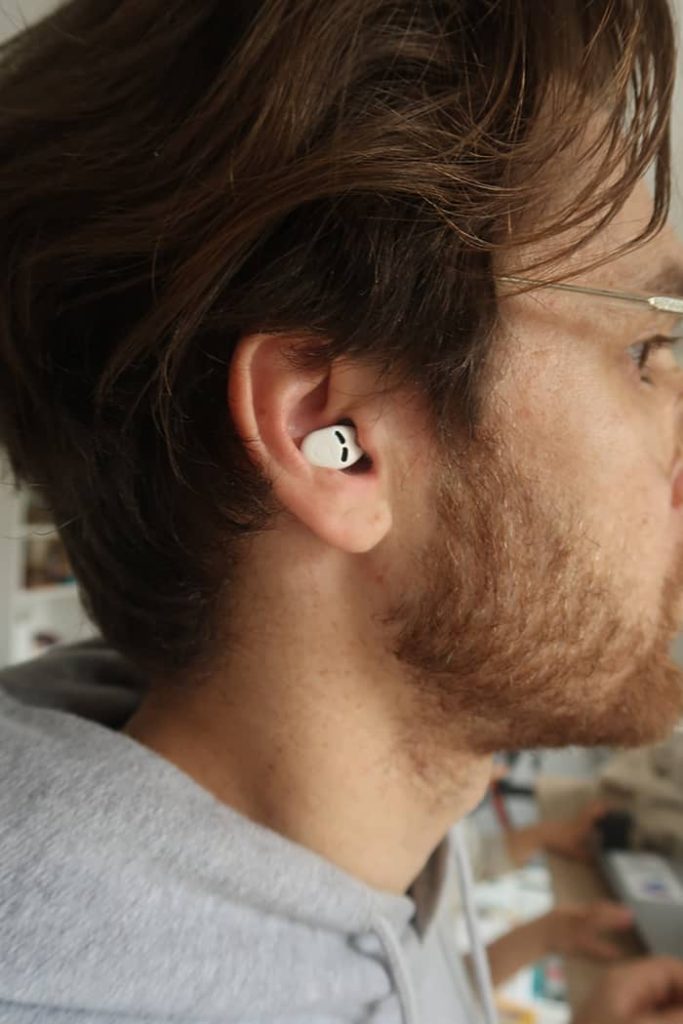
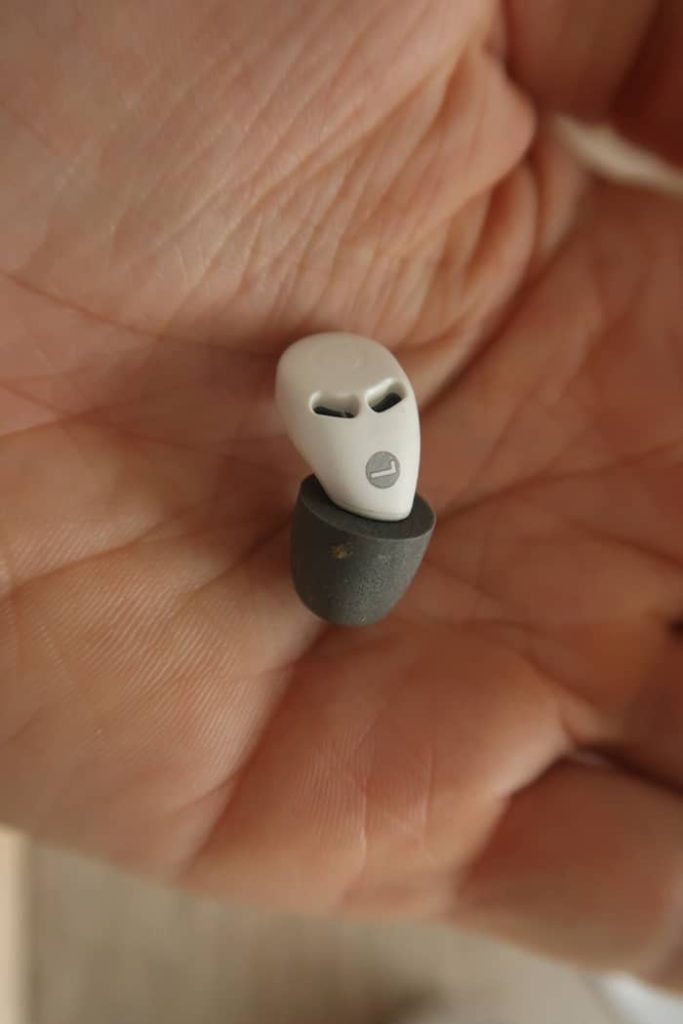
Active noise cancelling (ANC) technology
QuietOn sleepbuds are surprisingly simple. No buttons, no Bluetooth and no sound streaming. All you do is put them in your ears and after 20 seconds or so their active noise cancellation (ANC) automatically turns on. That’s it. But that’s the whole beauty – it simply turns down the volume of the world around you to give you space to relax.
Actually, when you put the sleepbuds on there’s already some noise cancellation happening already. The memory foam acts like a regular earplug and diffuses some ambient noise. That is what they call passive noise cancellation. However, once the ANC turns on and the sleepbuds reverse the low-frequency sounds, the world around just ‘switches off’.
The first time I put on these noise-cancelling sleepbuds I couldn’t hear my wife whispering to me and had to take out the sleepbuds to hear something which was pretty funny. In fact, the overall noise cancellation is so good that I even postponed testing these at night for some time, because both of our 2 small kids were sick and I thought (correctly) I wouldn’t be able to hear them at night.
Battery life & portability
QuietOn promises up to 28 hours of battery life for their noise-cancelling sleepbuds on a single charge. The case will provide power for 3 charges, which totals to quite a lot of noise cancellation – be it during traveling or sleeping at home.
Personally, I haven’t taken these to the limit and in my modest experience (which probably would be similar to a regular person’s usage) these lasted well. They survived my 10h travel day and never ran out of juice when I used them at night. I was, however, proactive with the charging.
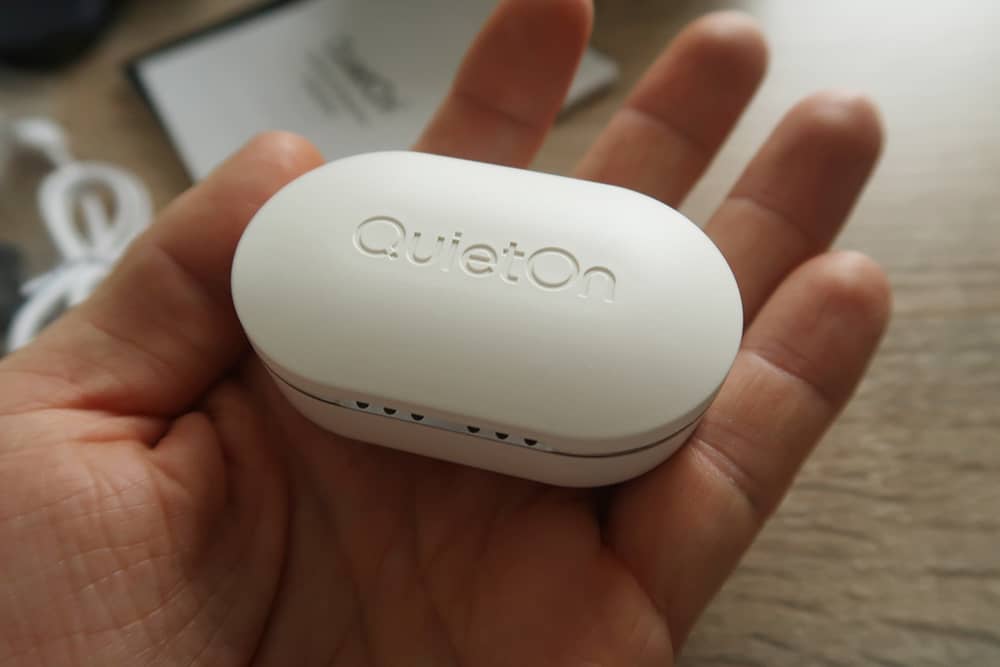
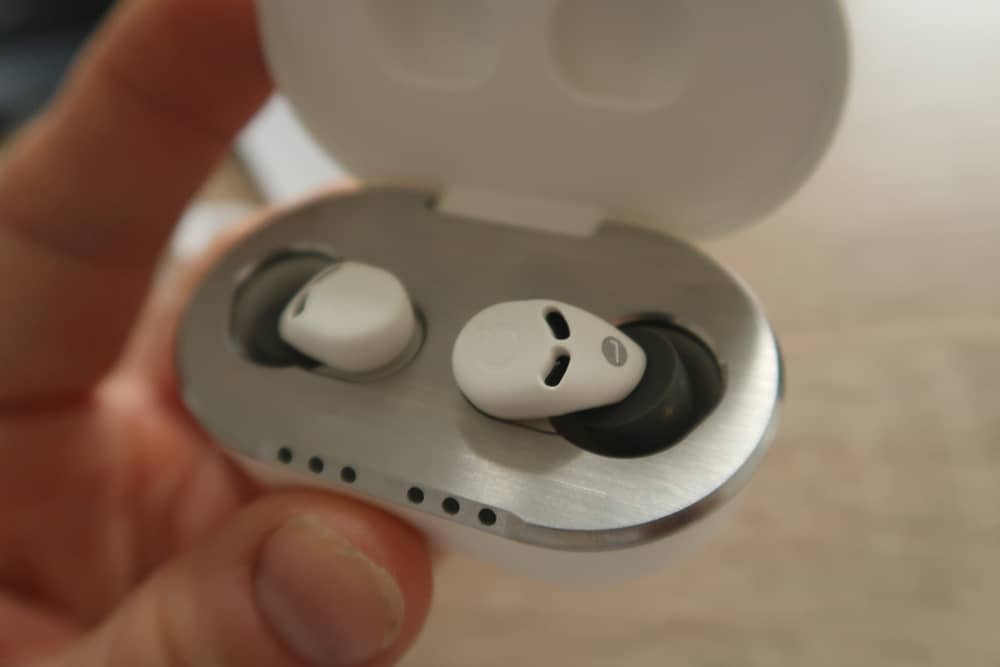
Sound quality
Nope. QuietOn has no sound.
As shared earlier, there’s no Bluetooth/WiFi connectivity or any music streaming, which I actually quite like. I don’t like having any technology in the bedroom and prefer to limit any interference at night. I even switch off the Bluetooth function on my Garmin, so that it doesn’t affect my sleep.
Adding an option to have soothing background music to fall asleep or breathing & meditation practice would make sense. But I don’t know if that’s technically possible without Bluetooth/WiFi functionality.
QuietOn 3.1 noise-cancelling sleepbuds – user experience
Coming to my personal experience, I’m usually a good sleeper. The neighbour’s dog doesn’t bother me, I don’t count sheep and I don’t have noise from the subway going across the Manhattan’s bridge just outside the window. Knock on wood.
With my training & work schedule I’m usually pretty tired and falling asleep takes care of itself. And I do pay extra attention to sleep hygiene to ensure I’m getting the most recovery every night. However, with 2 small kids who sleep in the same bed with us, often HRV and sleep quality are subpar, to say the least.
So, here’s where I put the sleepbuds to the test:
- Sleeping at home with two tossing toddlers – overall, slight upward tick in HRV and marginally higher sleep quality (~85 over 75-85 on average). Good result.
- On a trip in an airplane – felt calmer and experienced less stress during the entire trip. Massive success.
- Working from home with construction happening just outside my house – worked well to block out the construction noise (even with the window open) and help me focus. Good job.
- Working from home with toddlers playing in the other room – same as above, helped to block the overall noise. Focused work was interrupted anyway, as they kept coming into the room.
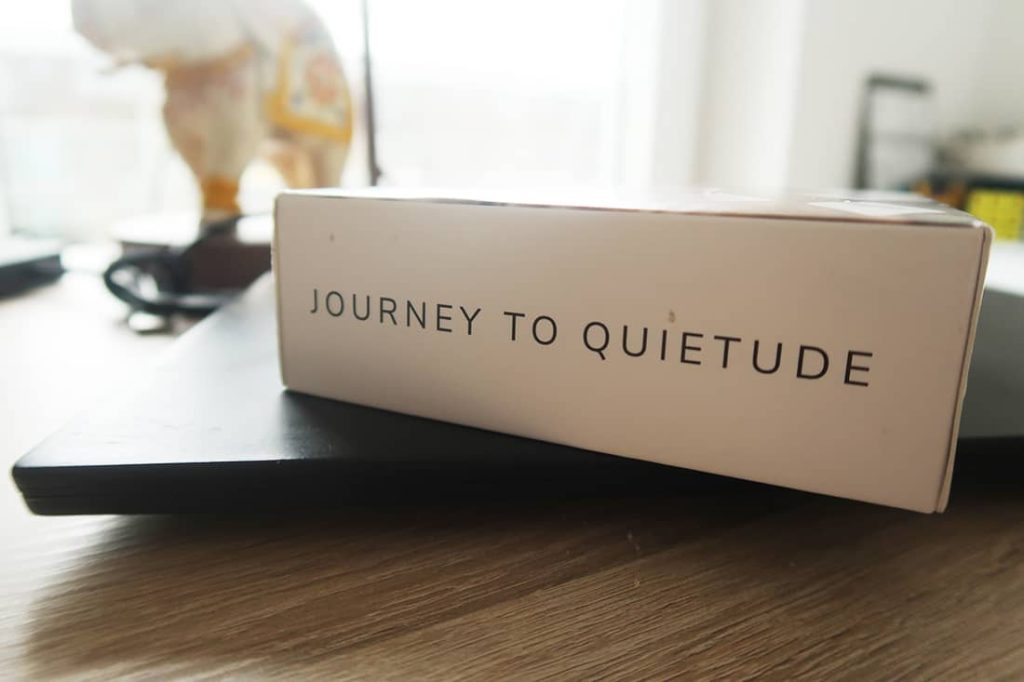
What I liked
As already shared, I did enjoy how well QuietOn 3.1 fit. I don’t like the feeling of regular earplugs in my ear (so I never tried sleeping with them on), but I was surprised by how comfortable it was to sleep in QuietOn’s noise-cancelling sleepbuds. I can imagine these would work great for someone living in a noisy neighbourhood. Especially in summer when it’s more tempting to open the window at night.
Next is the active noise-cancelling technology. I use my BOSE headset sometimes to do focused work, but it has Bluetooth enabled and with all the extra technology around my head I’m not keen on using them often. Quiet On’s sleepbuds, however, are something I can actually use not only for sleep, but also to do some focused work.
The way they work is, an internal microphone picks up the background noise and then generates a ‘phase-shifted’ sound to cancel it. Which means, they work really well to reduce constant noise and leave sharp sounds, like announcements, doors opening, people talking specifically to you, etc.
While QuietOn 3.1 had a slight improvement on my sleep quality (both perceived and Garmin-measured quality, as well as HRV data), where I enjoyed them to the fullest was on a trip. Comparing those to my BOSE headphones, these are very much up there in my ranking. And their portability scores massive bonus points against BOSE, because I don’t need to carry the large headset with me. The best part was that I could wear them also in the terminal without much hassle (I usually use BOSE only in the airplane itself). My wife enjoyed them as well, because it was easier to snooze on the plane with them on, compared to full headphones.
What QuietOn can improve
I genuinely loved the product and will definitely use these sleepbuds in my daily life. As such, there’s nothing specific that’s bad with them. The only two drawbacks I could come up with was price and comfort (for some).
On the comfort side, even though these are not as invasive as regular earplugs, the process still requires putting things into your ear. To this day many people are still uncomfortable with bass booster earphones (i.e. Apple’s AirPods Pro). I can imagine how challenging it would be to warm up to the idea of sleeping with things in your ear.
The second factor is price. At €259 this is not the cheapest product to introduce into your lifestyle only to improve sleep. Especially, given that QuietOn 3.1 has a single key feature – noise cancellation. People who have control over their sleep environment (i.e. noise, light, temperature) will, probably, be better off improving their sleep hygiene first.
Read also: Flying To Run A Race? Beat Jet Lag With These Expert Travel Tips
Should you buy QuietOn 3.1 noise-cancelling sleepbuds?
As shared, if you can improve your sleep quality naturally – you should. And even if you have a partner that snores like a chainsaw or you live next to a Manhattan bridge (which I experienced when I ran the NYC marathon), you might still get away with a regular set of earplugs.
However, if you’re looking to improve your focus throughout the day or are traveling a lot (or both), QuietOn 3.1 might be just the product for you.
As athletes we travel a lot and getting quality sleep is sometimes hard to come by. On top of a gruelling training schedule a night at the noisy hotel room or an uncomfortable nap on the plane can easily throw your recovery off track. That’s especially important when you travel for a race.
As I see it (and personally for me) noise-cancelling sleepbuds is a smart solution for athletes seeking to optimize their sleep quality during travel. And that’s the biggest takeaway from my test.
Andrejs
Related Posts
Leave a Reply Cancel reply
GET A FREE TRAINING PLAN
Subscribe to my email list and get access to a free 4-week “back in shape” training plan
You’ll also get two full-body strength sessions and some other goodies!

How did I get here?
Hey there! My name is Andrejs and I am here to inspire, entertain and get you fit for any adventure.
I went from being an over trained pro athlete to an endurance coach sharing how to listen to your body and live life to the fullest.
Traveling, new sports & activities brought new meaning to my training and made it much more effective, fun and enjoyable. And I'm here to help you do the same.
